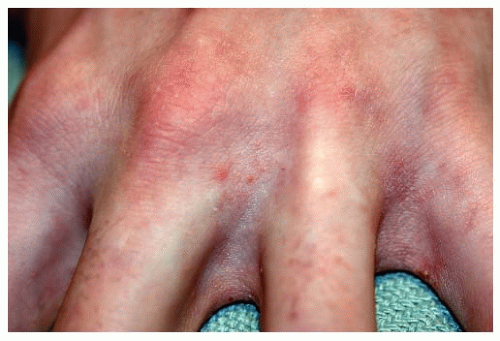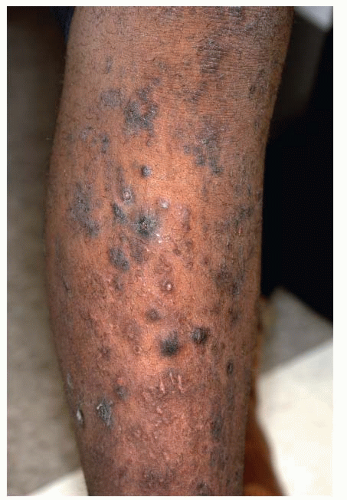Evaluation of Pruritus
Peter C. Schalock
Arthur J. Sober
Pruritus (itch) is an unpleasant cutaneous sensation that provokes the urge to scratch. It may be localized or generalized, or acute or chronic, and it may occur with or without skin lesions. In addition to the skin, it can occur on any epithelial surface, such as the conjunctivae, oropharynx, and anogenital region. Itching may be caused by a dermatologic condition, systemic illness, or psychological disturbance. The complaint is particularly common among the elderly, as the prevalence of itch increases with aging. It can prove especially challenging to the clinician when the etiology remains elusive and symptoms interfere with the patient’s daily functioning. The primary physician should be capable of performing a reasonably detailed evaluation and providing effective symptomatic relief.
Pathophysiology
The sensation of itching arises from a complex plexus of free nerve endings at the lower epidermis and dermal-epidermal junction in the skin, although an “itch receptor” remains elusive. These fibers are only found in the skin, especially concentrated in the flexor aspects of the wrist and ankles, and mucous membranes. Afferent transmission is through the myelinated A-delta and unmyelinated C fibers to the dorsal horn of the spinal cord, ascending to the contralateral spinothalamic tracts and terminating in the cerebral cortex. The scratch response is a spinal reflex and may abolish itch by central inhibition rather than attenuation of the peripheral sensory input. Many chemical mediators and modulators of itch have been suggested, including leukotriene B4, prostaglandin E2, substance P, histamine, opioid and nonopioid peptides, somatostatin, neurokinin A, serotonin, kinins, acetylcholine (ACh), and prostaglandins. Histamine plays a direct link in causing itch in conditions such as urticaria and mastocytosis. Leukotriene B4 and prostaglandin E2 induce itch in human skin. ACh mediates itch in patients with atopic dermatitis.
Various external stimuli decrease the threshold for itching. These include inflammation, heat, dryness, and vasodilation. Persons vary in their response to itching. There is a psychological influence on the perception of itching, which explains why a health care worker may experience itching after attending a patient with scabies or pediculosis.
A possible classification system for itch divides this sensation into four distinct categories. Neurogenic itch arises from neurophysiologic dysfunction such as cholestasis or medications. Neuropathic itch is caused by a primary neurologic disorder. Psychologic itch such as “delusions of parasitosis” is another category of pruritus. In the final category is the itch arising from skin disorders, dermatologic itch.
Clinical Presentation
Pruritus may be localized or generalized and can occur with or without skin lesions. Pruritus from a systemic disease can occur with or without a primary skin lesion.
Dermatologic Disease
A host of dermatologic conditions can present with itching.
Dry Skin (Xerosis).
Dry skin (xerosis; see Chapter 183) is the most frequent precipitant and is particularly common in older individuals due to age-related decreased production of skin lipids. Symptoms are worse in low indoor humidity, especially in the winter or with use of air conditioning. Examination of the skin with tangential light reveals fine scaling and cracking.
Urticaria.
Urticaria (see Chapter 181) is a common skin disorder characterized by edematous, erythematous, coalescing wheals with pale centers. Although very itchy, urticaria generally persists at a specific site for less than 24 hours, in contrast to urticarial vasculitis, which is a result of a small-vessel vasculitis, classically described clinically as burning, persisting beyond 24 hours, and associated with systemic complaints (especially gastrointestinal and musculoskeletal). Patients usually give a history of wheals and demonstrate dermographism (urticaria on stroking the skin with a blunt object).
Dermatitis Herpetiformis.
Dermatitis herpetiformis can have a subtle presentation, with few skin manifestations, but vesicles are characteristic, although excoriations may obliterate them. Often, pruritus will cease once the vesicle is unroofed by scratching. An intense burning sensation often predates the appearance of skin lesions.
Scabies.
Scabies can have a subtle presentation. Infestation is endemic in long-term care facilities, such as nursing homes and neuropsychiatric institutions. In persons with good hygiene, there may be fewer than 10 of the characteristic burrowing-induced skin lesions (Fig. 178-1) (see Chapter 195). At times, the only finding may be nonspecific papules caused by an immune skin response.
Atopic Dermatitis.
Atopic dermatitis (also referred to by some as eczema) is a chronic, inflammatory, pruritic skin condition seen with increased frequency in patients with allergic rhinitis/seasonal allergies and a personal or family history of asthma (known as the “atopic triad”). A vicious itch-scratch cycle, in which scratching induces further inflammation and skin damage, often ensues. Unlike the other dermatologic disorders mentioned, atopic dermatitis lacks a primary skin lesion, and so the secondary changes produced by the inflammation are varied. A patient with chronic atopic dermatitis may exhibit scaly, hyper-, or hypopigmented plaques with lichenification (thickened skin with accentuation of skin lines) or weeping, erythematous, and possibly superinfected papules and plaques during an acute phase.
Prurigo.
Prurigo nodules are extremely pruritic, multiple, isolated hyperkeratotic nodules (Fig. 178-2) caused by a variety of etiologies, including atopy, pregnancy, and systemic disease. Often, the cause is elusive. As in atopic dermatitis, often there is a vicious cycle of itch-scratch. These nodules develop on the extremities as a result most commonly of skin picking, but also develop with rubbing or scratching. Prurigo may be associated with an underlying anxiety disorder. Psychogenic/emotional causes are common.
Renal Disease
Pruritus may accompany severe chronic renal failure, especially in patients receiving hemodialysis, in which up to 80% may experience this unpleasant sensation. The pruritus of renal disease does not correlate with plasma histamine levels and is unresponsive to antihistamines. Secondary hyperparathyroidism causing hyperphosphatemia may contribute to pruritus in these patients. Other investigations have implicated neuropathy, anemia, general xerosis, and endopeptidases or kinins as substances that can accumulate in uremia.
Neuropathy
The main finding with neuropathy is usually paresthesia and not itching. Neuropathy often causes “pins and needles” type of sensations that evoke the desire to rub, not scratch. The most common dermatologic disease associated with pruritus is notalgia paresthetica, a condition of chronic upper back pruritus of unclear etiology, possibly from spinal nerve entrapment/trauma. Brachioradial pruritus presents as chronic intermittent pruritus of the brachioradial region of the arm and is an isolated neuropathy of the cutaneous branch of the radial nerve. Treatment for these conditions is discussed later.
Endocrine Disease
Generalized itching occurs among 4% to 11% of patients with Graves disease, usually when the disease is long-standing. Increased kinin activity and augmented cutaneous blood flow resulting in elevated skin temperatures are suggested mechanisms. Hypothyroidism can also involve widespread pruritus, probably due to xerosis. The mechanisms for other endocrinopathies are poorly understood, although pruritus in diabetes may in some instances involve local irritation due to candidiasis.
Liver Disease
Among the many disorders of the liver, obstructive cholestatic jaundice produces the most pruritus. Itching may be especially prominent and can be the presenting manifestation in primary biliary cirrhosis, which occurs almost exclusively in middleaged women. About 20% to 25% of patients with jaundice are plagued with itching, although it is rare in the absence of cholestasis. Nevertheless, there is little correlation between the serum bile salt concentration and itch intensity. Pruritus of cholestasis has been linked to opioid peptides and the release of proteases in the skin by the bile salts. Itching during the last trimester of pregnancy, called intrahepatic cholestasis of pregnancy or pruritus gravidarum, has been reported in 1% to 3% of expectant women and is believed to be cholestatic in origin, although jaundice is uncommon.
Hematologic Disease
Generalized pruritus in an elderly or middle-aged patient should prompt the clinician to consider an underlying malignancy and pursue a directed workup based on the history and physical exam. The itching affects 30% to 50% of patients with polycythemia vera (PCV), often on the lower extremities.
The itching is induced often by a hot shower or bath. Pruritus may precede the development of PCV by years. In mycosis fungoides (cutaneous T cell lymphoma), pruritus is exceedingly common and has been suggested as an adverse prognostic factor. Hodgkin disease may also cause pruritus, although its role as a prognostic indicator is less than previously thought. Histamine release by an increased number of circulating basophils and cholestasis are postulated mechanisms for this type of itch. Pruritus has also been found in association with iron deficiency anemia, although the mechanism is unexplained and there is no correlation between itch and disease severity. Human immunodeficiency virus (HIV) infection causes progressive itch in some patients, related possibly to hypereosinophilia, prostaglandin synthesis, and peripheral neuropathy. Pruritus has also been reported to occur in Waldenström macroglobulinemia, hypereosinophilic syndrome, multiple myeloma, and systemic mastocytosis.
Psychiatric Disease
Patients with neurotic scratching report that they scratch even in the absence of itching. Itching is reported to occur more often at night, when other stimuli are lacking. Although the excoriations of this “neurodermatitis” may occur anywhere the patient can reach, they tend to be concentrated on the extremities. Depression and dysphoric mood are particularly common among such patients, as are serious conflict and situational stress preceding the onset of pruritus.
The conditions that cause itching may be dermatologic, systemic, or psychological in origin (Table 178-1). Skin disorders account for the vast majority. Pruritus may be localized or generalized. Localized itching is usually a sign of a primary dermatologic condition, dermatophyte infection, infestation, or psychological disorder. Generalized itching raises the possibility of a systemic condition or a psychogenic etiology, although dermatologic disease still predominates. In the older age groups, the most common cause of itching is xerosis.







